Approximately 6,500 Hmong live at the Huay Nam Khao camp in Phetchabun, 4,500 of which arrived in Thailand during the last year. Most paid between bt6,000 and bt30,000 to human traffickers to help them reach Phetchabun, situated in the heart of central Thailand.
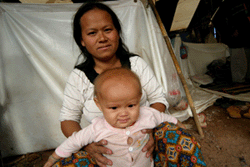 The remaining 2,000 Hmong are mostly ‘leftovers’ from the Wat Tham Krabok camp in Saraburi, which closed down after 15,000 Hmong were relocated to the U.S. in 2005.
The remaining 2,000 Hmong are mostly ‘leftovers’ from the Wat Tham Krabok camp in Saraburi, which closed down after 15,000 Hmong were relocated to the U.S. in 2005.
Human rights watchdog Amnesty International has issued a statement warning that if the group is forced to return to Laos they could face serious human rights violations including torture, ill-treatment and possibility execution.
In December Thailand forcibly repatriated 26 Hmong children and one adult who are still being detained by Lao authorities at an undisclosed location.
Hmong seeking shelter in Thailand claim they or their relatives supported a CIA-backed secret war in Laos from 1961 to 1975 and are fleeing persecution by the communist Lao government.
Thailand has also expressed a strong interest in immediately repatriating a group of 231 Hmong, many of whom are children, who were arrested along the border with Laos on June 5. For the past two months they have been held in squalid conditions at seven overcrowded jails in Phetchabun Province.
 I recently visited the Khao Kho jail where 82 Hmong are being held. Inside the detention facility men, women and children are crammed together in cells at night spreading out where they can and sleeping on the cement floor and during the day they are allowed outside where they sit on plastic mats under a small tent-covered area. When I asked to speak with and photograph some of the detainees the authorities objected, though I later returned when the detainees were unsupervised and was able to photographs them while they were being held outdoors.
I recently visited the Khao Kho jail where 82 Hmong are being held. Inside the detention facility men, women and children are crammed together in cells at night spreading out where they can and sleeping on the cement floor and during the day they are allowed outside where they sit on plastic mats under a small tent-covered area. When I asked to speak with and photograph some of the detainees the authorities objected, though I later returned when the detainees were unsupervised and was able to photographs them while they were being held outdoors.
Unwanted
The message coming from the governments of Laos, Thailand and the U.S. is clear: the Hmong simply aren’t welcome.
Laos refuses to admit that the Hmong refugees in Phetchabun originated in Laos, and indeed, they have been quick to label the camp an ‘internal problem’ of Thailand’s.
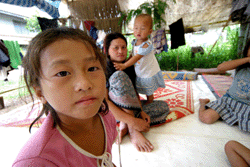 The U.S. government, for its part, has no plans to relocate any additional Hmong to the U.S., and Thailand feels that giving the Hmong in Phetchabun refugee status would only encourage more to flood across Thailand’s borders.
The U.S. government, for its part, has no plans to relocate any additional Hmong to the U.S., and Thailand feels that giving the Hmong in Phetchabun refugee status would only encourage more to flood across Thailand’s borders.
So far it’s proving problematic for Thai authorities to determine which Hmong are from Laos, which are from Thailand, which have legitimate ties to the CIA-backed secret war and which are simply trying to capitalize on an opportunity to emigrate to the U.S.
Obstacles to Aid
The major obstacle to providing aid to the Hmong in Phetchabun is that the U.N. has no mandate in Thailand. Because the Thai government has been unwilling to declare them as refugees-choosing instead to classify the Hmong as illegal immigrants-UNHCR simply cannot intervene. Consequently, there is a serious lack of food at Huay Nam Khao.
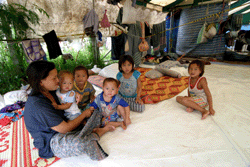 There are only two NGOs with a long-term stake at the camp and only one, Relief Logistics International (RLI), has a budget allocation for food. RLI provides 1kg of rice per person every 7 to 10 days, but the ration only lasts 2 to 3 days and then people are left to fend for themselves.
There are only two NGOs with a long-term stake at the camp and only one, Relief Logistics International (RLI), has a budget allocation for food. RLI provides 1kg of rice per person every 7 to 10 days, but the ration only lasts 2 to 3 days and then people are left to fend for themselves.
Because the Thai government won’t allow them to work residents at the camp have no way to legally earn money. Some illegal trade and ‘secret’ industries have sprung up, but security forces have been cracking down on these lately. There has also been a crackdown on residuals-money sent from Lao-American family members in the U.S.-entering the camps, which many people counted on to supplement their rations.
Choosing to remain anonymous, one high ranking military official supervising the camp explained that the Thai government doesn’t provide food because officially the Hmong are viewed as criminals. “Our mission is to control and contain them until they are sent back to Laos. We are just here to supervise,” he said.
But many of the police and military personnel charged with the responsibility of providing security at the Huay Nam Khao camp admit they also feel sympathy for the Hmong.
“I feel a great deal of pity for them,” one officer said, “because many have fled from a bad situation
from being killed in Laos. But I’m not happy that they’ve come and tried to set up a camp [in Phetchabun].”
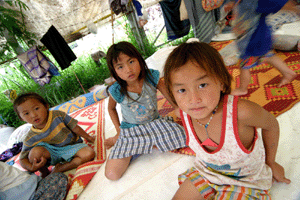 Most likely, ISOC will try to find a new temporary location to transfer the Hmong within Thailand until a plan can be devised to send them back to Laos. At the moment there is still some freedom for the Hmong to go in and out of the camp, but as one aid worker put it, “[The new camp] will be like a prison.”
Most likely, ISOC will try to find a new temporary location to transfer the Hmong within Thailand until a plan can be devised to send them back to Laos. At the moment there is still some freedom for the Hmong to go in and out of the camp, but as one aid worker put it, “[The new camp] will be like a prison.”
Cracking Down
In March security forces set up a checkpoint to restrict movement and have been cracking down on what, and who, goes in and out of the camp.
The checkpoint is allegedly meant to reduce the trafficking of drugs, illegal materials, and money sent from Lao-American families. The government also claims the checkpoint is in place to protect national security though it is more likely there to protect the ‘national image’ as cameras, visiting family members from the U.S. and foreign journalists have all been banned.
In the end, their justifications seem like empty covers, dramatic fabrications to justify censorship and the recent crackdown.
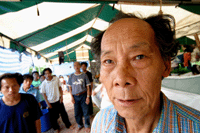 In one incident at the camp a video camera given to a Hmong pastor so he could record sermons was confiscated after he was seen recording footage outside the church. The camera was eventually returned to the NGO that provided it to him. For his offence, the pastor was sentenced to community service.
In one incident at the camp a video camera given to a Hmong pastor so he could record sermons was confiscated after he was seen recording footage outside the church. The camera was eventually returned to the NGO that provided it to him. For his offence, the pastor was sentenced to community service.
Health Concerns
According to Médecins Sans Frontières (MSF), health conditions in the camp have been improving, but are far from ideal. In addition to the serious lack of food, space is inadequate and the housing situation is dire.
“In some cases there are three to four families under one roof,” said one MSF worker. “With people living so close together it’s easy for diseases to spread.”
MSF conducts approximately 500 consultations per week. The more complicated cases get referred to nearby hospitals, but most medical care is administered at a temporary facility in the camp.
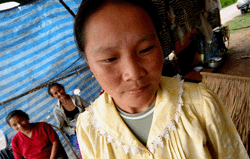 “We try to focus on the vulnerable people
those under age five and pregnant women.” There are between 1,500-1,700 children under the age of five at the Huay Nam Khao camp, and there have been approximately 200 births there during the last year.
“We try to focus on the vulnerable people
those under age five and pregnant women.” There are between 1,500-1,700 children under the age of five at the Huay Nam Khao camp, and there have been approximately 200 births there during the last year.
According to MSF, approximately 10% of children in the camp are malnourished. “We’ve had some cases with children who are under weight. For a long time they just weren’t receiving the proper diet.”
Skin, lung and eye infections, as well as diarrhea and viral rashes are all common problems in the camp. “It’s difficult to do bacteria control in an environment like this
the camp is susceptible to a variety of outbreaks. TB could be a problem in the future. The conditions are right here.”
But for the Hmong, even tuberculosis is a small risk to take given the potential abuses that await if they were to be forcibly returned to Laos. In fact, most would much prefer to undertake the arduous task of waiting out the U.S. government. It’s an ambitious goal given the number of years the Karen-another minority ethnic group with ties to armed militants-have been lingering in refugee camps in Thailand.
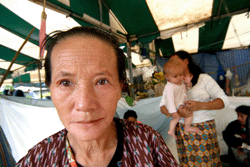 Yet, if we are to learn anything from the Karen it is that hope is inherently imbedded in perseverance. Many of the Karen have spent over a decade in refugee camps, but recently U.S. lawmakers waived an old law preventing thousands of Karen from being resettled in the U.S. for supporting the armed Karen National Union. Now, up to 2,700 Karen are scheduled to be resettled this year.
Yet, if we are to learn anything from the Karen it is that hope is inherently imbedded in perseverance. Many of the Karen have spent over a decade in refugee camps, but recently U.S. lawmakers waived an old law preventing thousands of Karen from being resettled in the U.S. for supporting the armed Karen National Union. Now, up to 2,700 Karen are scheduled to be resettled this year.
It may just be wishful thinking, but if it can happen once it could happen again. The Hmong are a patient people. After all, patience and perseverance, it could be said, are the only things that have gotten many of them this far.
All photos by Will Baxter.
